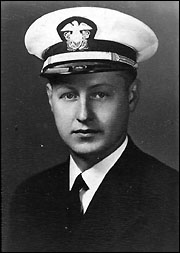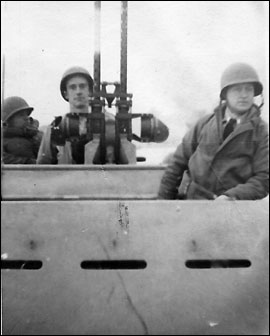D-Day sailor honored posthumously
 Chester Hendrickson kept his war stories in the attic. After participating in five major landings in World War II, the Paynesville native returned home, joined his brother in farming the family homestead, got married, and raised a family. He kept his citations and his medals with his naval uniforms in a trunk in the attic.
Chester Hendrickson kept his war stories in the attic. After participating in five major landings in World War II, the Paynesville native returned home, joined his brother in farming the family homestead, got married, and raised a family. He kept his citations and his medals with his naval uniforms in a trunk in the attic.Chester Hendrickson participated in five major amphibious landings during World War II aboard the USS Charles Carroll. Hendrickson, who earned a Bronze Star Medal for his work during the landings at Normandy on June 6, 1944, was awarded posthumously the Jubilee of Liberty Medal from the French government last week.
Dorothy, his widow, did not learn most of the details of his war service until she opened that trunk following his death in November 1987.
"He really saw a lot," said Dorothy. "He never talked about it much. He'd say, 'Some things are better left unsaid.' I think the things they saw were too horrible (to talk about)."
Since she knew Chester served at Normandy during the D-Day landings, Dorothy became interested in the Jubilee of Liberty Medal, an award issued by the French government to commemorate the 50th anniversary of the D-Day landings.
First this medal was given only to servicemen who participated in the landings and attended the D-Day anniversary celebration. Then it was offered to any living servicemen who participated in D-Day.
Dorothy realized that deceased servicemen were eligible for the award after seeing a story about Rudolph Nelson in the Press last summer. She contacted the office of Congressman Mark Kennedy and Chester Hendrickson received a Jubilee of Liberty Medal in Litchfield on Thursday.
"Mostly, I did it for the kids and grandkids," said Dorothy, "because I think it's important that the next generation knows what this generation did."
Chester Hendrickson was born in 1920 on the family farm in Union Grove Township, five miles south of Lake Koronis. His grandfather had homesteaded the property after immigrating from Norway in 1869. While a senior at Augsburg College, he enlisted in the navy in 1942, volunteering for duty so he could choose his branch of service. He was commissioned as an ensign in February 1943 and rose to the rank of lieutenant.
 He spent most of his service time on the USS Charles Carroll, an amphibious transport, and participated in five major landings: at Sicily in July 1943; at Salerno, Italy, in September 1943; at Normandy during the D-Day landings on June 6, 1944; at southern France in August 1944; and at Okinawa in April 1945.
He spent most of his service time on the USS Charles Carroll, an amphibious transport, and participated in five major landings: at Sicily in July 1943; at Salerno, Italy, in September 1943; at Normandy during the D-Day landings on June 6, 1944; at southern France in August 1944; and at Okinawa in April 1945.
He earned a European Theater Service Medal and a Pacific Theater Service Medal. It was rare to serve in both theaters of war, said Dorothy.
At Sicily in July 1943, the Charles Carroll used 61 landing craft - with Hendrickson in command of one ship - to land troops in darkness in rough seas without the loss or serious injury to a single man.
At Salerno in September 1943, under heavy fire, Hendrickson negotiated his landing ship through a mine field to the beach. Unlike Sicily, this attack was not a surprise. "Salerno was a different story," Hendrickson told the Press while home on leave in January 1944. "It was supposed to be a sneak attack, but it turned out to be no secret to the enemy. 'Bloody Salerno' is an appropriate name."
At that time, Hendrickson said the most nerve-wracking ordeal he ever encountered was two and a half hours under fire from enemy dive bombers on the evening his ship left Salerno.
He earned a Bronze Star Medal at Normandy "for efficiency, courage, and devotion to duty during the landing of assault troops by the USS Charles Carroll" at Normandy on June 6, 1944.
"Undaunted in the face of devastating enemy machine gun and artillery fire," wrote John L. Sullivan, the Acting Secretary of the Navy in awarding Hendrickson the Bronze Star Medal, "Lieutenant Hendrickson skillfully directed his vessel through enemy-mined waters and, despite extreme hazards of darkness and inclement weather, succeeded in escorting the leading assault wave to the designated beach at the scheduled time. Under his capable leadership, his men rendered valiant service in delivering close-in rocket fire and in assuming traffic control and rescue duties. By his cool courage and unwavering determination under adverse conditions, Lieutenant Hendrickson contributed materially to the success of our operations in this area and upheld the highest traditions of the United States Naval Service."
Due to the rough seas at Sicily and Normandy, not predicted by the navy weathermen, Chester never trusted weather predictions again, said Dorothy.
Rescuing men from the bloody water was the worst job, Chester told Dorothy. Because of their heavy packs, some men would get tipped over in the water after leaving the landing craft and drown. Others would be hit by enemy fire. Chester was told to focus on retrieving only the living from the bloody water.
 Dorothy, who describes herself as a World War II nut now, imagines Chester faced enemy fire at Omaha Beach at Normandy similar to the depiction in the opening scene of the movie Saving Private Ryan.
Dorothy, who describes herself as a World War II nut now, imagines Chester faced enemy fire at Omaha Beach at Normandy similar to the depiction in the opening scene of the movie Saving Private Ryan.
But she did not know that back in 1944. She and Chester were friends who had grown up together, attending the same church and the same country school, though Chester was five years older. They corresponded throughout his war service, with Dorothy sending a couple letters per week to Chester. (They got married in 1947, after he was discharged from the navy, raised four kids, and stayed married for 40 years, until Chester died after a 12-year struggle with cancer.)
Dorothy Hendrickson, Chester's widow, displays the Bronze Star and Jubilee of Liberty medals earned by her late husband.
Though the date for D-Day was secret in 1944, the invasion was not. Everyone knew the Americans and British were going to land in France and try to push the Germans out of western Europe. The only question was when and where.
Dorothy was working at the Swedish Hospital in Minneapolis on June 6, 1944. By the time she arrived for her 7 a.m. shift, news reports were pouring in about the invasion, which had started hours earlier. "The patients who had radios got real long baths because I wanted to hear the news," said Dorothy.
She knew Chester was taking part in the landings but did not know where, or if he was alright. It took weeks for her to get a letter from Chester and hear that he was alive. "I suppose I didn't hear that he was dead," she recalled, which was good news.
After participating in another landing in southern France in August 1944, Chester came home on leave for Thanksgiving 1944 but was called back to duty and his ship went through the Panama Canal on its way to the Pacific Ocean. He then participated in the landings at Okinawa, near Japan, in April 1945.
"The thing he talked about at Okinawa was the kamikazes, the suicide dive bombers," said Dorothy. "That was terrifying."
But Chester did not like talking about his war experiences, said Dorothy. He said little but had started saying more before he died.
All the World War II veterans saw horrible things, said Dorothy, and just wanted to get home and get on with their lives. "It's just amazing that they were able to do that," she said.
Contact the author at editor@paynesvillepress.com • Return to News Menu
Home | Marketplace | Community